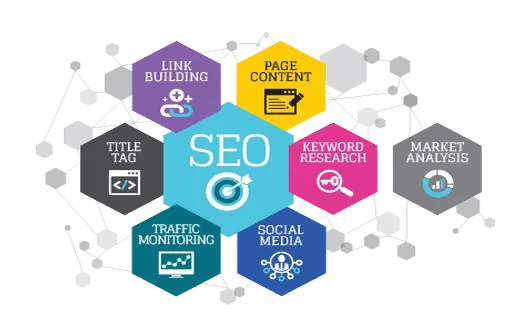
SEO Content Optimization: A Beginner’s Guide to Crafting SEO Content [2025]
In the world of digital marketing, new and innovative ideas flow constantly. The practice of SEO content optimization, for instance, never remained stagnant in terms of strategies. Specialists discover new techniques every year, which help to appease all existing search engines and their complex algorithms today. This evolution is equally visible in Website and Mobile Apps development, where information architecture, speed, and user trust now directly influence organic visibility.
Take Google’s ranking signals, for example. Core and spam updates now roll out multiple times a year, and AI Overviews (launched broadly in 2024) parse, quote, and rank pages based on clarity and expertise—often powered by models similar to ChatGPT. These updates are programmed to analyze and evaluate content to ensure that users get the most relevant and useful answers for their queries. In return, they drive a considerable amount of online traffic to pages that deliver genuinely helpful, up-to-date information.
Having that said, the importance of search engine optimization to your online-marketing efforts remains sky-high—especially now that most consumers rely on the internet for virtually every purchase decision, both offline and online.
If you are not yet aware of how SEO marketing works, let us help you learn SEO piece by piece using our free beginners’ guide to content optimization. Shall we?
What is SEO?

In layman’s terms, Search Engine Optimization (SEO) is the practice of enhancing the quality of online content and the technical performance of a website to boost visibility on search-engine results pages (SERPs). Technically, it comprises various factors that work together to optimize every online asset you publish.
To further understand, here are the crucial elements of SEO you should know:
Keyword. A keyword is a single word or a set of words used to generate traffic for a particular niche. These phrases are derived from different search queries Google and other search engines receive every day. They guide a content marketer by showing exactly what people are searching for. In return, they help create unique content that is useful and relevant to users.
Note: For more comprehensive information about keyword usage, read the SEO best-practice notes we discuss below.
On-page optimization. To perform SEO content optimization, a strict set of rules called on-page optimization must be implemented properly. You should learn how to integrate keywords, schema markup, and accessibility tags correctly. Done right, these steps boost searchability and satisfy modern Core Web Vitals.
Content organization. Content organization refers to the systematic placement of information on a website. Logically structured pages make it easy for visitors—and AI Overviews—to locate answers quickly. It’s also a direct ranking factor for Google in 2025.
Content marketing. Distribution is the other half of optimization. Social shares, internal links, and high-authority external links signal trust and expand reach across the open web.
Different Types of SEO Content
Marketers rely on several major content formats in 2025. Here are the most effective and how they work:
- Blog posts. Evergreen or timely posts that educate, entertain, and attract qualified prospects.
- Articles. Formal news pieces, expert interviews, and thought-leadership editorials—often picked up by Google News.
- Product pages. Detailed, conversion-oriented pages used by e-commerce sites to rank for transactional intent.
- Guides. Long-form “ultimate” resources that earn backlinks, capture leads, and support E-E-A-T.
- Infographics. Highly shareable visual summaries that drive brand mentions and off-page signals.
3 Tricks to Perform SEO Content Optimization Effectively

Driving traffic to your website is straightforward once you master SEO content optimization. Below are three battle-tested tips—updated for Google’s 2025 landscape—to guide you.
1. Use Keywords to Your Advantage

Keywords connect user queries to your content. In 2025, tools such as Google Keyword Planner, Ahrefs, SEMrush, and entity analysis in Surfer or Frase tell you whether a phrase fuels AI Overviews, classic blue links, or both. Prioritize search-intent alignment over raw volume.
However, if you select keywords blindly, you risk attracting the wrong audience. Below we revisit each keyword type and show how they apply today.
Different Types of Keywords
User Intent • Still divided into Informational, Transactional, and Navigational—but Google’s Helpful Content System now also recognizes “Dig-Deeper” intent that triggers follow-up AI suggestions. Keep your FAQ ready.
- Informational. “what is climate change”
- Transactional. “buy noise-canceling headphones”
- Navigational. “ahrefs pricing”
Search-Volume Buckets (2025)
- Head terms. One-word, broad, AI-overview-heavy; competitive.
- Mid-tail. 2–3 words; balanced difficulty.
- Long-tail. 4 words +; lower volume but converts well.
How to Determine the Right Keyword
Step 1 – Check Keyword Difficulty. Ahrefs KD, SEMrush Keyword Difficulty, or Moz PA/DA still work. Balance against SERP complexion—including AI cards and video packs.
Step 2 – Evaluate Search Volume and Trend. Use Google Trends to ensure the topic isn’t declining. Remember: micro-intent queries with lower volume can outperform generic phrases in conversion.
Step 3 – Confirm Relevance & Timeliness. A phrase might be popular but off-topic for your brand. Quality beats quantity every time.
Step 4 – Can You Integrate It Naturally? Readability remains a top ranking factor. Write headlines that hook first—then weave in the keyword without forcing it.
Trustworthy Keyword Tools (Still Current)
- SEMrush
- Ahrefs
- Google Trends
- Google Keyword Planner
- Moz KD Explorer
- AccuRanker
- KeywordTool.io
- Ubersuggest
- Term Explorer
- Frase (for entity analysis)
2. Optimize Your Content
SEO content optimization is meticulous work. Plan ahead and allocate time for drafting, on-page checks, and Core Web Vitals testing.
Create Long and Useful Content
Google’s 2023-2025 Helpful Content System, RankBrain, and Core updates continue to reward depth, originality, and user satisfaction. Thin, recycled material still gets demoted.
So how do you write long-form pieces that rank and delight readers like Alpha Multimedia? Follow these modern rules:
Step 1 – Leverage Informational and Commercial Keywords Together
Informational keywords build trust. Commercial keywords attract buyers. Combine both in pillar posts so users can seamlessly transition from learning to purchasing.

Informational keywords. Usually start with “how to”, “what is”, “why does”.
Commercial keywords. Include modifiers like “best”, “vs”, “review”, “pricing”.
Step 2 – Answer Real Questions
Tools such as AnswerThePublic, AlsoAsked, and Outranking’s SERP Compass reveal the exact follow-up questions users type. Incorporate those into FAQ or “People Also Ask” sections—this increases passage-ranking and AI Overview citations.
On-page Optimization (2025 Checklist)
- Title Tag & H1. Focus keyword in the first 60 characters; wrap headline in <h1>.
- Subheadings. Use H2-H3 hierarchy; include primary or secondary keyword early.
- First 100 Words. Mention the focus phrase once—naturally.
- URL Slug. Keep it short-and-clean (e.g., /seo-content-optimization).
- Meta Description. Up to 155 characters, compelling, includes focus KW.
- Images & Alt-text. Compress, define width/height, descriptive alt (may include a partial keyword).
- Internal Links. 3–4 relevant pages; use natural anchor text.
- External Authority. 1–2 links to trusted, non-competing sources (ADA.gov, OSHA.gov, SGIA.org, etc.).
- Schema. Article, FAQ, and HowTo markup increases CTR and answer-box chances.
Optimize Image Alternative Text
Google Images now powers visual search and AI image citations. Descriptive alt-text helps your graphics rank on their own and supports visually impaired users.
Leverage the Power of Link Building
Internal links establish topical clusters; external links transfer credibility. Consider modern white-hat tactics: digital PR, podcast guesting, and data-driven studies.
Leveraging 2025 Tools & Tech
- Cora SEO Audit — deep-dive correlation analysis.
- Page Optimizer Pro — NLP scoring and EEAT guidance.
- Cognitive SEO — site-wide content + link audit.
- Surfer SEO — “SGE readiness” score for AI Overviews.
- Frase — automated briefs & FAQ schema.
- ChatGPT (OpenAI) — lightning-fast outline drafting, question mining, and SERP-snippet prototyping.
3. Optimize Your Site to Support Content SEO
Even perfect content won’t rank if your site is slow, unstable, or not mobile-friendly. Google’s Core Web Vitals (LCP, INP, CLS) remain baseline metrics for quality.
Site Speed

Aim for LCP < 2.5 s, INP < 200 ms, and CLS < 0.1. Tools: PageSpeed Insights, WebPageTest, GTmetrix.
Mobile-friendliness

Since Google completed the switch to mobile-first indexing in 2021, every page is evaluated on its smartphone rendering first. Use responsive CSS frameworks, optimize tap targets, and lazy-load imagery.
Conclusion
Proper SEO content optimization is mission-critical. The fundamentals haven’t changed since 2019—quality, relevance, and technical health—but 2025 adds new layers: AI Overviews, INP Core Web Vital, ChatGPT-level content assistants, and stricter E-E-A-T signals. Apply the updated guidelines above, and your content won’t just reach hundreds of viewers; it will reliably serve (and grow) thousands who need it.
